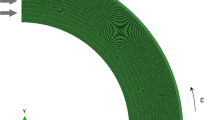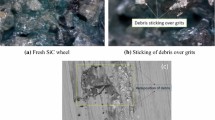Abstract
To study the influence mechanisms of tool geometry parameters on surface quality and subsurface damage when nanocutting polycrystalline NiFeCr superalloys, based on the theory of molecular dynamics, a three-dimensional nanocutting model is established. By investigating the mechanisms of material removal, cutting force, friction coefficient, surface roughness, residual stress, dislocation density, and phase transformation atoms, the influences of the tool rake angles, edge radii, and clearance angles on the surface and subsurface structures are analysed in detail. At the initial cutting stage, the material removal mechanism is dominated by tool extrusion, and as cutting continues, the dominant removal mechanism transforms into shearing. When the tool rake angle changes from negative to positive, the surface roughness improves, the dislocation density and phase transformation atoms decrease, and the tensile residual stress increases. As the edge radius increases, the surface roughness and dislocation density increase, the tensile residual stress decreases, and the phase transformation atoms first increase and then decrease. With the increased tool clearance angle, the surface roughness and phase transformation atoms decrease, the tensile residual stress increases first and then decreases, and the dislocation density shows fluctuating characteristics. In addition, an analysis of dislocation and defect evolution reveals the plastic deformation and subsurface damage mechanisms during nanocutting. In particular, grain boundaries help to inhibit the proliferation of defect damage and dislocations, and the interactions of dislocations form new dislocations.




















Similar content being viewed by others
References
Chen MS, Ma YY, Lin YC, Lou YM, Li HB, Wang GQ, Chen Q (2022) An innovative annealing treatment method and its mechanism to refine deformed mixed grains of initial aged GH4169 superalloy. J Alloy Compd 907:164325
Thakur A, Gangopadhyay S (2016) State-of-the-art in surface integrity in machining of nickel-based super alloys. Int J Mach Tools Manuf 100:25–54
Hao ZP, Cui RR, Fan YH, Lin JQ (2019) Diffusion mechanism of tools and simulation in nanoscale cutting the Ni–Fe–Cr series of nickel-based superalloy. Int J Mech Sci 150:625–636
Nagaraj A, Min S (2022) Effect of crystallography on residual stresses during ultra-precision machining of sapphire. CIRP Ann 71(1):101–104
Liu CL, Chu JN, Zhang JG, Zhang JJ, Chen X, Xiao JF, Xu JF (2021) Effect of tool rake angle on the material removal mechanism transition of single-crystal silicon: a molecular dynamics study. Int J Adv Manufac Technol 115(11):3631–3644
Chen N, Yuan Y, Guo C, Zhang XL, Hao XQ, He N (2020) Design, optimization and manufacturing of polycrystalline diamond micro-end-mill for micro-milling of GH4169. Diam Relat Mater 108:107915
Ma JW, Jia ZY, He GZ, Liu Z, Zhao XX, Qin FZ (2019) Influence of cutting tool geometrical parameters on tool wear in high-speed milling of Inconel 718 curved surface. Proc Inst Mech Eng Part B: J Eng Manuf 233(1):18–30
Esmaeili H, Adibi H, Rezaei SM (2021) Study on surface integrity and material removal mechanism in eco-friendly grinding of Inconel 718 using numerical and experimental investigations. Int J Adv Manuf Technol 112(5):1797–1818
Gao Y, Lu C, Huynh NN, Huynh G, Zhu HT, Tieu AK (2009) Molecular dynamics simulation of effect of indenter shape on nanoscratch of Ni. Wear 267(11):1998–2002
Fang FZ, Zhang N, Guo DM, Ehmann K, Cheung B, Liu K, Yamamura K (2019) Towards atomic and close-to-atomic scale manufacturing. Int J Extreme Manuf 1(1):012001
Liu HT, Zhu XF, Sun YZ, Xie WK (2017) Evolution of stacking fault tetrahedral and work hardening effect in copper single crystals. Appl Surf Sci 422(15):413–419
Dai HF, Du H, Chen JB, Chen GY (2019) Investigation of tool geometry in nanoscale cutting single-crystal copper by molecular dynamics simulation. Proc Inst Mech Eng Part J: J Eng Tribol 233(8):1208–1220
Han XS, Lin B, Yu SY, Wang SX (2002) Investigation of tool geometry in nanometric cutting by molecular dynamics simulation. J Mater Process Technol 129(1–3):105–108
Sharma A, Datta D, Balasubramaniam R (2018) Molecular dynamics simulation to investigate the orientation effects on nanoscale cutting of single crystal copper. Comput Mater Sci 153:241–250
Doan DQ, Fang TH, Chen TH (2022) Nanomachining characteristics of textured polycrystalline NiFeCo alloy using molecular dynamics. J Manuf Process 74:423–440
Fan YH, Wang WY, Hao ZP, Zhan CY (2020) Work hardening mechanism based on molecular dynamics simulation in cutting Ni–Fe–Cr series of Ni-based alloy. J Alloy Compd 819:153331
Hao ZP, Lou ZZ, Fan YH (2020) Influence of anisotropy of nickel-based single crystal superalloy in atomic and close-to-atomic scale cutting. Precis Eng 66:347–362
Xu DD, Edwards TE, Liao ZR, Maeder X, Ramachandramoorthy R, Jain M, Johann M, Axinte D (2021) Revealing nanoscale deformation mechanisms caused by shear-based material removal on individual grains of a Ni-based superalloy. Acta Mater 212:116929
Fung KY, Tang CY, Cheung CF (2017) Molecular dynamics analysis of the effect of surface flaws of diamond tools on tool wear in nanometric cutting. Comput Mater Sci 133:60–70
Bonny G, Terentyev D, Pasianot RC, Poncé S, Bakaev A (2011) Interatomic potential to study plasticity in stainless steels: the FeNiCr model alloy. Modell Simul Mater Sci Eng 19(8):085008
Maekawa K, Itoh A (1995) Friction and tool wear in nano-scale machining-a molecular dynamics approach. Wear 188(1–2):115–122
Xie JY, Chen NX, Shen J, Teng LD, Seetharaman S (2005) Atomistic study on the structure and thermodynamic properties of Cr7C3, Mn7C3, Fe7C3. Acta Mater 53(9):2727–2732
Tersoff J (1989) Modeling solid-state chemistry: interatomic potentials for multicomponent systems. Phys Rev B 39(8):5566–5568
Wang JS, Zhang XD, Fang FZ, Chen RT (2018) A numerical study on the material removal and phase transformation in the nanometric cutting of silicon. Appl Surf Sci 455:608–615
Shet C, Deng XM (2000) Finite element analysis of the orthogonal metal cutting process. J Mater Process Technol 105(1–2):95–109
Liu LJ, Lv M, Wu WG, Zhu XJ (2015) Experimental study on the chip morpholgy in high speed milling Ti-6Al-4V alloy. J Mech Eng 51(3):196–205
Xu J, Wang CX, Feng PF, Jiang EL, Feng F (2023) Meso-scale cracks initiation of Nomex honeycomb composites in orthogonal cutting with a straight blade cutter. Compos Sci Technol 233:109914
Furukawa YJ, Moronuki N (1988) Effect of material properties on ultra precise cutting processes. CIRP Ann 37(1):113–116
Chavoshi SZ, Goel S, Luo XC (2016) Influence of temperature on the anisotropic cutting behaviour of single crystal silicon: a molecular dynamics simulation investigation. J Manuf Process 23:201–210
Günay M, Aslan E, Korkut I, Seker U (2004) Investigation of the effect of rake angle on main cutting force. Int J Mach Tools Manuf 44(9):953–959
Xu YS, Wan ZH, Zou P, Huang WL, Zhang GQ (2021) Experimental study on cutting force in ultrasonic vibration-assisted turning of 304 austenitic stainless steel. Proc Inst Mech Eng Part B: J Eng Manuf 235(3):494–513
Shimada S, Ikawa N, Tanaka H, Uchikoshi J (1994) Structure of micromachined surface simulated by molecular dynamics analysis. CIRP Ann 43(1):51–54
Li Y, Shuai MB, Zhang JJ, Zheng HB, Sun T, Yang Y (2018) Molecular dynamics investigation of residual stress and surface roughness of cerium under diamond cutting. Micromachines 386:1–14
Yen YC, Jain A, Altan T (2004) A finite element analysis of orthogonal machining using different tool edge geometries. J Mater Process Technol 146(1):72–81
Jiang JQ, Dong ZW, Ma HW, Sun LH (2022) Computational investigation on the surface cutting of γ-TiAl alloy. Solid State Commun 342:114618
Cheong WC, Zhang LC (2000) Molecular dynamics simulation of phase transformations in silicon monocrystals due to nano-indentation. Nanotechnology 11(3):173–180
Dai HF, Chen GY, Zhou C, Fang QH, Fei XJ (2017) A numerical study of ultraprecision machining of monocrystalline silicon with laser nano-structured diamond tools by atomistic simulation. Appl Surf Sci 393:405–416
Liu Y, Xu DD, Agmell M, Saoubi RM, Ahadi A, Stahi JE, Zhou JM (2021) Numerical and experimental investigation of tool geometry effect on residual stresses in orthogonal machining of Inconel 718. Simul Model Pract Theory 106:102187
Wang H, Dong Z, Yuan S, Guo XG, Kang RK, Bao Y (2022) Effects of tool geometry on tungsten removal behavior during nano-cutting. Int J Mech Sci 225:107384
Xu J, Feng P, Feng F, Zha HT, Liang GQ (2021) Subsurface damage and burr improvements of aramid fiber reinforced plastics by using longitudinal–torsional ultrasonic vibration milling. J Mater Process Technol 297:117265
Fang FZ, Xu FF, Lai M (2015) Size effect in material removal by cutting at nano scale. Int J Adv Manuf Technol 80(1):591–598
AlMotasem AT, Bergström J, Gaard A, Krakhmalev P, Holleboom LJ (2017) Atomistic insights on the wear/friction behavior of nanocrystalline ferrite during nanoscratching as revealed by molecular dynamics. Tribol Lett 65(3):1–13
Sharma A, Datta D, Balasubramaniam R (2018) An investigation of tool and hard particle interaction in nanoscale cutting of copper beryllium. Comput Mater Sci 145:208–223
Zhu ZX, Peng B, Feng RC, Wang LJ, Jiao S, Dong Y (2019) Molecular dynamics simulation of chip formation mechanism in single-crystal nickel nanomachining. Sci China Technol Sci 62:1916–1929
Gurrutxaga LB (2017) How strong is the temperature increase due to a moving dislocation? Int J Solids Struct 108:263–274
Johnson DC, Kuhr B, Farkas D, Was GS (2019) Quantitative linkage between the stress at dislocation channel–grain boundary interaction sites and irradiation assisted stress corrosion crack initiation. Acta Mater 170:166–175
Dahlman P, Gunnberg F, Jacobson M (2004) The influence of rake angle, cutting feed and cutting depth on residual stresses in hard turning. J Mater Process Technol 147(2):181–184
Fang Z, Yan YD, Li ZH, Zhang AX, Geng YQ (2023) Molecular dynamics simulation of the tool geometry effect on nanowire formation behavior during nanoskiving. Mater Des 225:111498
Yamakov V, Wolf D, Phillpot SR, Mukherjee AK, Gleiter H (2002) Dislocation processes in the deformation of nanocrystalline aluminium by molecular-dynamics simulation. Nat Mater 1(1):45–49
Chen B, Wu WP (2021) Molecular dynamics simulations of dynamics mechanical behavior and interfacial microstructure evolution of Ni-based single crystal superalloys under shock loading. J Market Res 15:6786–6796
Funding
This work is supported by the Hebei Provincial Key Research Projects (grant no. 20311007D).
Author information
Authors and Affiliations
Contributions
Junqiang Jiang: software, writing—original draft preparation, and data analysis. Zhaowei Dong: funding, review, and editing original draft. Hongwei Ma: methodology, investigation, and chapter layout. Lihui Sun: supervision, funding, and auxiliary drawing.
Corresponding author
Ethics declarations
Ethics approval
We promise that our research work will always conform to ethical standards.
Competing interests
The authors declare no competing interests.
Additional information
Publisher's note
Springer Nature remains neutral with regard to jurisdictional claims in published maps and institutional affiliations.
Rights and permissions
Springer Nature or its licensor (e.g. a society or other partner) holds exclusive rights to this article under a publishing agreement with the author(s) or other rightsholder(s); author self-archiving of the accepted manuscript version of this article is solely governed by the terms of such publishing agreement and applicable law.
About this article
Cite this article
Jiang, J., Sun, L., Ma, H. et al. Influence mechanisms of tool geometry parameters on surface quality and subsurface damage in polycrystalline NiFeCr superalloys. Int J Adv Manuf Technol 127, 3637–3653 (2023). https://doi.org/10.1007/s00170-023-11730-5
Received:
Accepted:
Published:
Issue Date:
DOI: https://doi.org/10.1007/s00170-023-11730-5




